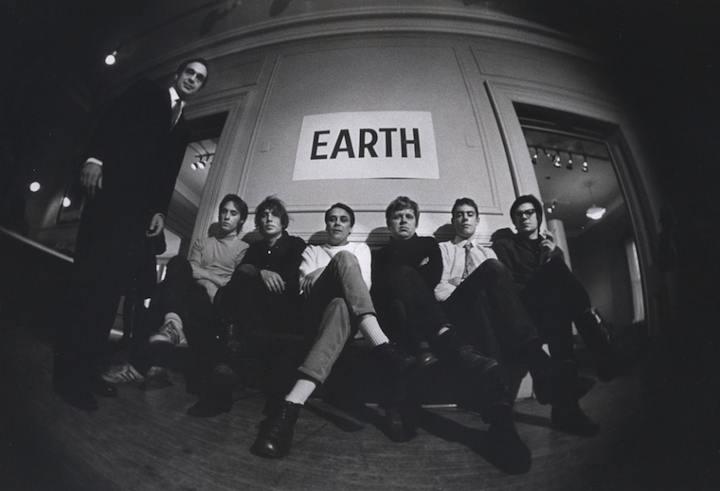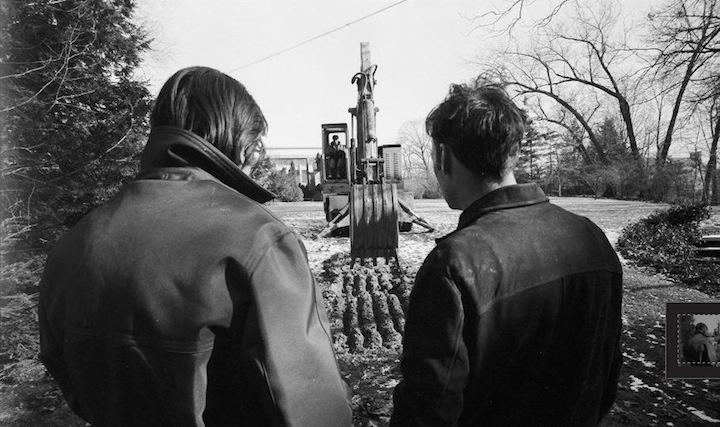neither big, red, nor shiny: earth art
Land Art, embracing sculpture as media, sculpture as performance, as photography, as activism, as philosophy didn’t even bear that name when the first museum exhibition in the US took place, in 1969—40 years ago next month. Flying under the radar, outside the sphere of museums and commercial galleries, earth art was one of a number of art practices formulated by outliers taking a shot at museum and gallery art world conventions.
That show, Earth Art, was organized by independent curator and film/video/installation artist Willoughby Sharp (1936–2008), at Cornell University’s Andrew Dickson White Museum of Art. It presented site-specific installations by 12 international artists in the Museum and outdoors, trickling off-campus into Ithaca, which at the time was a small town.
Most of the participating artists were on site for about a week to make new pieces for the exhibition, with the help of students from the University, including Gordon Matta-Clark and Louise Lawler. David Medalla from the Philippines sent instructions for his piece by mail, while Robert Morris called in his instructions by telephone—he could not make it to Ithaca because of a blizzard.
 Above: Neil Jenney, Dennis Oppenheim, Günther Uecker, Jan Dibbets, Richard Long,
and Robert Smithson (seated, left to right) with Thomas W. Leavitt (1930–2010), Director, A. D. White Museum of Art, Cornell University (standing), at the Earth Art Symposium, February 4, 1969.
Below: Unidentified photograph made at the time of the Earth Art installations. Photographs courtesy the Cornell University Library, Division of Rare and Manuscript Collections.
Above: Neil Jenney, Dennis Oppenheim, Günther Uecker, Jan Dibbets, Richard Long,
and Robert Smithson (seated, left to right) with Thomas W. Leavitt (1930–2010), Director, A. D. White Museum of Art, Cornell University (standing), at the Earth Art Symposium, February 4, 1969.
Below: Unidentified photograph made at the time of the Earth Art installations. Photographs courtesy the Cornell University Library, Division of Rare and Manuscript Collections.
Around the time of the opening, the museum presented a symposium on earth art. But the long out-of-print catalogue of the show was produced a year later, because at the time of the opening, it was not clear which of the artists invited would ultimately participate. Michael Heizer and Walter de Maria briefly exhibited in the show but were not mentioned in the catalogue. Carl Andre was also invited but declined to participate.
The catalogue is a remarkable time capsule, showing the influence of high Modernist design, American-style, notably practiced by Massimo Vignelli—a favorite of Modernist architects of the time [Ed.: Cornell is noted for its MFA architecture program]. With several essays, artist bios, more than 40 black-and-white photographs, and transcripts from the symposium, the catalogue offers an indelible view of one of the strongest and most influential art movements of the late 20th century in its nascent years. The catalogue is now accessible in its entirety online.

While at the time earth art was not an art-world label, and the curator did not promote that notion,
there were notable similarities among the artists in their approach and use of materials. In the catalogue's Foreword, Thomas W. Leavitt, the museum’s director, wrote, “Earth art is
one facet of a general tendency among younger artists to renounce the construction of art objects in favor of the creation of art experiences related to abroad physical and sociological
environment.
“If this tendency prevails, it could ultimately transform the entire structure of the art world. Museums wishing to support the efforts of contemporary artists may have to think increasingly in terms of backing projects rather than acquiring art objects or holding conventional exhibitions. A basic revamping of most museum budgets would be required to effect this change but several forward-looking institutions have already begun to think in these terms….It is even conceivable that a new kind of museum, a true ‘museum without walls,’ could come into being….”
And now, a new exhibition of contemporary art, of and influenced by earth art, opens this Saturday at Cornell University:
beyond earth
art | contemporary artists and the environment. On view January 25-June 8 at the Herbert F. Johnson Museum of Art, Cornell University, Ithaca, NY. Information
Artists on view January 25–May 11: Ansel Adams, Matthew Brandt, Adam Cvijanovic, Blane De St. Croix, Olafur Eliasson, Rose-Lynn Fisher, Noriko Furunishi, Patricia Johanson, Chris Jordan, Maria Park, Alexis Rockman, Alison Elizabeth Taylor
Artists on view January 25–June 8: Michael Ashkin, Brandon Ballengée, Anna Betbeze, Troy Brauntuch, Edward Burtynsky, Agnes Denes, Mark Dion, Chris Doyle, Jack Elliott, Dionisio González, Christian Houge, Yun-Fei Ji, David LaChapelle, Maya Lin, Ana Mendieta, Robert Morris, Jean-Luc Mylayne, Dennis Oppenheim, Maggie Puckett, Allan Sekula, Robert Smithson, Alan Sonfist, Michelle Stuart, Maarten Vanden Eynde, Marion Wilson, Yang Yi
Among the public programs are a talk by Maya Lin on April 10; and a schedule of video screenings from January 25 to June 8. Complete schedule of events, programs and workshops here.
The exhibition Food-Water-Life/Lucy+Jorge Orta, organized by the Tufts University Art Gallery, is also on view as part of the Beyond Earth project.


